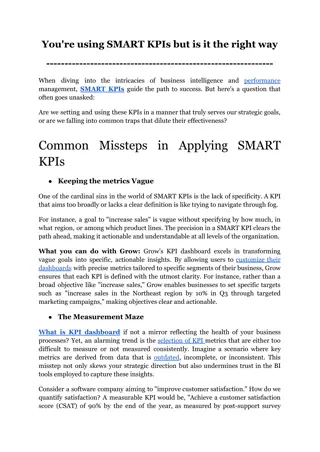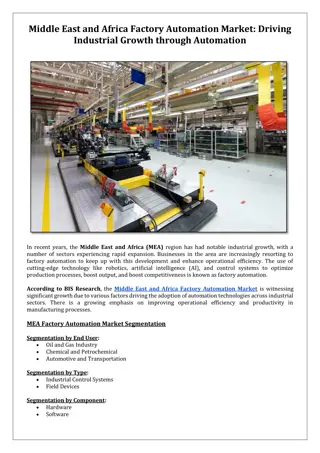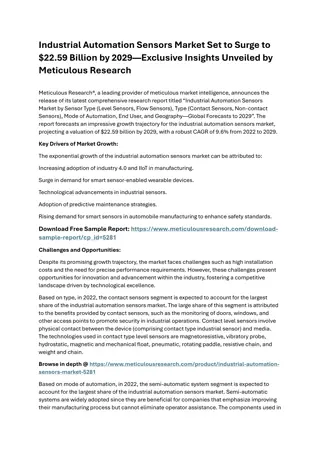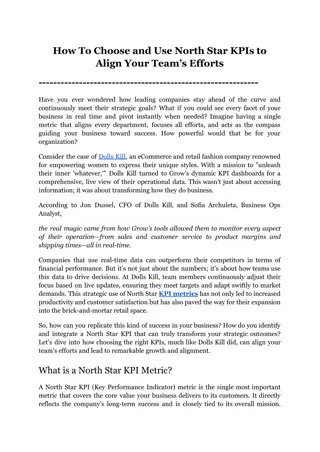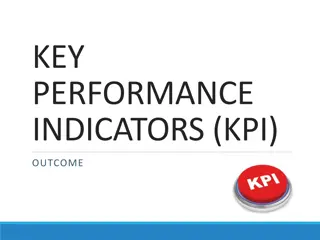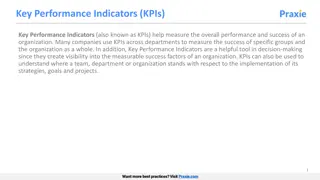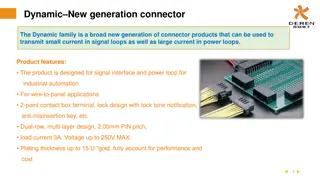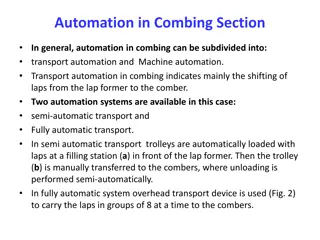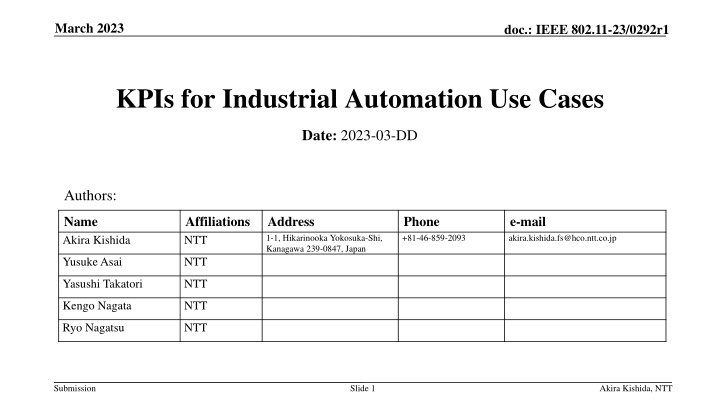
KPIs for Industrial Automation Use Cases
This document discusses the importance of Key Performance Indicators (KPIs) for industrial automation use cases in the context of Wi-Fi business applications such as robotics, logistics, and smart agriculture. It explores the need for target numbers, latency considerations, reliability, throughput, and the comparison with existing standards. The focus is on addressing the specific requirements and challenges in ensuring efficient and reliable wireless communication for industrial IoT applications.
Download Presentation

Please find below an Image/Link to download the presentation.
The content on the website is provided AS IS for your information and personal use only. It may not be sold, licensed, or shared on other websites without obtaining consent from the author. If you encounter any issues during the download, it is possible that the publisher has removed the file from their server.
You are allowed to download the files provided on this website for personal or commercial use, subject to the condition that they are used lawfully. All files are the property of their respective owners.
The content on the website is provided AS IS for your information and personal use only. It may not be sold, licensed, or shared on other websites without obtaining consent from the author.
E N D
Presentation Transcript
March 2023 doc.: IEEE 802.11-23/0292r1 KPIs for Industrial Automation Use Cases Date: 2023-03-DD Authors: Name Akira Kishida Affiliations NTT Address 1-1, Hikarinooka Yokosuka-Shi, Kanagawa 239-0847, Japan Phone +81-46-859-2093 e-mail akira.kishida.fs@hco.ntt.co.jp Yusuke Asai NTT Yasushi Takatori NTT Kengo Nagata NTT Ryo Nagatsu NTT Submission Slide 1 Akira Kishida, NTT
March 2023 doc.: IEEE 802.11-23/0292r1 Introduction The SP in the January meeting confirmed that Wi-Fi business use cases such as robotics and industrial automation for industrial IoT, logistics, and smart agriculture are considered important targets for the UHR amendment[1]. This contribution discusses following two topics; If the UHR PAR requires the target number, the number of latency bound and reliability for industrial automation use cases can be utilized for the target. To show the advancement compared to the EHT, deterministic (periodic) and non- deterministic (sporadic) low latency traffic are important for industrial automation, and UHR should consider covering both types of QoS traffic. Submission Slide 2 Akira Kishida, NTT
March 2023 doc.: IEEE 802.11-23/0292r1 Specific target numbers for KPIs in the PAR EHT PAR includes at least one feature that realizes improved worst case latency/jitter for the Scope of the project. The target values of those metrics are not clarified and defined in the Scope of the project part. In January discussions, the 802.11 WG chair mentioned as follows. [3] Given the process of establishing the program, we need the numbers. It is clear the group and the SA needs to do. Need several use cases, like some numbers to meet the VR requirements. (from discussions from UHR SG Jan 2023 meeting minutes) We have not a resolution for this topic some resolutions will be required. Therefore, we introduce the KPIs and the numbers of industrial automation from the RTA report for the UHR PAR. Submission Slide 3 Akira Kishida, NTT
March 2023 doc.: IEEE 802.11-23/0292r1 KPIs for industrial automation The RTA report [2] introduces KPIs of Latency bound, reliability, and throughput for each industrial automation service class including AR/VR. Class A Class B Class C Applications and Requirements Applications Interactive video, soft-real- time mobile robotics, Automated Guided Vehicles (AGV) 10-1 s AR/VR, remote HMI, hard-real-time control, machine tools, production lines Hard-real-time isochronous control, motion control, printing, packaging cyclic control, We could consider Class A and B applications as targets, and an indicated number of 10-1ms latency bound is worth considering for the target of the UHR PAR. This table defines the latency bound as the worst-case one-way latency measured at the application layer. Reliability is expressed as the percentage of packets expected to be received within the latency bound. Time synchronization ~1 s ~1 s Latency bound 50 -10 ms 10 1 ms 1ms 250 s Reliability 99% - 99.9% 99.9% - 99.99% >99.999% Throughput High (video) Low robotics, AGVs) High (VR) Moderate-Low (controls/automation/AR) Moderate-Low (control, 1 Submission Slide 4 Akira Kishida, NTT
March 2023 doc.: IEEE 802.11-23/0292r1 Target number of the latency bound in the PAR Latency bound in the wireless links is case-sensitive because it depends on the environments of Wi-Fi networks, which vary according to each use case. The RTA report shows requirements as the numbers of latency bound and reliability for industrial automation use cases. The UHR can utilize these as the target number for the PAR. The UHR PAR could express the target for latency bound as follows; "This amendment defines at least one mode of operation capable of XXX of latency bound in industrial automation scenarios. " XXX can be referred to requirements of application Classes from the RTA report. Mainly, Class B includes several use cases, such as AR/VR, remote HMI, hard real-time cyclic control, machine tools, and production lines. Submission Slide 5 Akira Kishida, NTT
March 2023 doc.: IEEE 802.11-23/0292r1 Types of traffic of industrial automation Use Cases in the IEC/IEEE 60802 [4] indicates industrial automation traffic type summary as shown. Some traffic types are sporadic traffic, such as network control, alarms/events, etc. Latency bound is an important KPI here, and the KPI for not only deterministic (periodic) but also non-deterministic (sporadic) low latency traffic should be considered for UHR. Submission Slide 6 Akira Kishida, NTT
March 2023 doc.: IEEE 802.11-23/0292r1 Candidate technologies proposed in UHR SG Several contributions [5]-[14] proposed so far in the UHR SG improve latency characteristics for deterministic (periodic) and/or non-deterministic (sporadic) low latency traffic. Channel access enhancement (including R-TWT, triggered access) [7][9][10][11][14] Preemption [5][8][13] Multi-AP enhancement [6] Overhead reduction [9][12] UHR should manage latency bound and reliability by enhancing and combining those technologies. Submission Slide 7 Akira Kishida, NTT
March 2023 doc.: IEEE 802.11-23/0292r1 Summary We introduced and discussed the target number of KPIs for industrial automation from the RTA report and the IEC/IEEE 60802 document. We could indicate the target number for the latency bound of industrial automation in the UHR PAR. Deterministic (periodic) and non-deterministic (sporadic) low latency traffic should be considered for UHR. Submission Slide 8 Akira Kishida, NTT
March 2023 doc.: IEEE 802.11-23/0292r1 SP 1 Do you agree that UHR target improvement for deterministic (periodic) and non-deterministic (sporadic) latency characteristics? -Yes -No -Abstain Submission Slide 9 Akira Kishida, NTT
March 2023 doc.: IEEE 802.11-23/0292r1 SP 2 Do you agree that the UHR PAR should have the target number for the latency bound and reliability of industrial automation? NOTE: Use cases of industrial automation are described in the RTA report [2]. -Yes -No -Abstain Submission Slide 10 Akira Kishida, NTT
March 2023 doc.: IEEE 802.11-23/0292r1 SP 3 What industrial automation class is the most suitable for the target of the UHR PAR? NOTE: Industrial automation classes are described in the RTA report [2]. -Class A only -Class A and B -Class A, B, and C -None of then Submission Slide 11 Akira Kishida, NTT
March 2023 doc.: IEEE 802.11-23/0292r1 References [1] Akira Kishida, et al., Considerations on UHR PAR and KPIs, IEEE 802.11-22/1919r5 [2] Kate Meng, et al., RTA report draft, IEEE 802.11-18/2009r6 [3] Ross Jian Yu, UHR SG Jan 2023 meeting minutes, IEEE 802.11-23/0094r0 [4] Belliardi Rudy , et al., IEC/IEEE 60802 Use Cases for Industrial Automation (TSN-IA Profile for Industrial Automation), [5] Wook Bong Lee, et al., Latency Reduction Scheme for UHR, IEEE 802.11-22/1393r0 [6] Liuming Lu, et al., Multi-AP Coordination for Low Latency Traffic Delivery, IEEE 802.11-22/1556r1 [7] Tongxin Shu, et al., Requirements of Low Latency in UHR, IEEE 802.11-22/1519r1 [8] Thomas Handte, et al., Latency and Reliability enhancements for UHR, IEEE 802.11-22/1880r1 [9] Dmitry Akhmetov, et al., Challenges to achieve low latency, IEEE 802.11-22/1926r0 [10] Ziyang Guo, et al., Follow-up on Latency Reduction with Machine Learning Techniques, IEEE 802.11- 22/1931r1 [11] Kazi Huq, et al., Enhanced Trigger-Based Uplink Transmission, IEEE 802.11-22/2009r6 [12] Leonardo Lanante, PPDU Design for Short Frames, IEEE 802.11-22/1939r0 [13] Kiseon Ryu, et al., Low Latency Support in UHR, IEEE 802.11-23/0018r1 [14] Liuming Lu, et al., Urgency-based Delivery of Latency Sensitive Traffic, IEEE 802.11-23/0045r1 [15] Osama Aboul-Magd, 802.11 HEW SG Proposed PAR, IEEE 802.11-14/0165r1 Submission Slide 12 Akira Kishida, NTT




